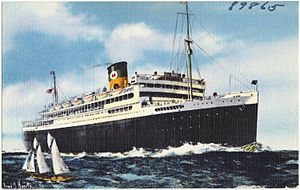SS Brazil (1928)

Artist's impression of SS Brazil, 1938–41 or 1948–58
|
|
| History | |
|---|---|
|
|
|
| Name: |
|
| Namesake: | |
| Owner: |
|
| Operator: |
|
| Port of registry: | New York |
| Route: |
|
| Builder: | Newport News Shipbuilding |
| Completed: | 1928 |
| Maiden voyage: | 8 December 1928 |
| In service: | 1928 |
| Out of service: | laid up 1958 |
| Identification: |
|
| Fate: | scrapped 1964 |
| General characteristics | |
| Tonnage: | |
| Length: | 586.4 ft (178.7 m)p/p |
| Beam: | 80.3 ft (24.5 m) |
| Depth: | 20.5 ft (6.2 m) |
| Installed power: | 2,833 NHP |
| Propulsion: |
|
| Speed: |
|
| Capacity: |
|
| Crew: |
|
| Sensors and processing systems: |
|
| Notes: | |
SS Brazil was a US turbo-electric ocean liner. She was completed in 1928 as SS Virginia, and refitted and renamed as SS Brazil in 1938. From 1942 to 1946 she was the War Shipping Administration operated troopship Brazil. She was laid up in 1958 and scrapped in 1964.
Virginia was the second of three sister ships built by the Newport News Shipbuilding and Drydock Company of Newport News, Virginia for the American Line Steamship Corporation, which at the time was part of J. P. Morgan's International Mercantile Marine Co. She joined SS California (launched in 1927) in the fleet of American Lines' Panama Pacific Lines subsidiary. A third sister, SS Pennsylvania, was launched in 1929.
Virginia was a steamship, with oil-fired furnaces heating her boilers to power two General Electric steam turbo generators with a combined rating of 2,833 NHP supplying current for her electric propulsion motors.
Virginia was equipped with submarine signalling apparatus and wireless direction finding equipment, and from about 1934 she was equipped with a gyrocompass.
As built, Virginia had accommodeation for 184 first class and 365 tourist class passengers. 52 of her first class cabins were state rooms. Some of her first class cabins had en suite bathrooms.
...
Wikipedia
